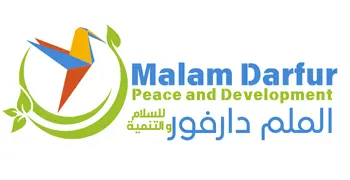Peaceful Coexistence Conference, September 2018
Malam Darfur Peace & Development (MDPD) was established upon a deep understanding of the importance of peace and reconciliation in creating stability in war-torn Darfur communities since 2003.
Al-Malam locality had been the center for the rural areas in South Darfur state before the war. Since the war broke out, it reflected the implications of war on the communities. Therefore, Al-Malam locality was the stage for launching MDPD’s peace and reconciliation conference. In 2011, MDPD held a mapping conference in Nyala, capital of South Darfur state in November 2011. One of the major takeaways from that conference was seeing how committed the people were to peace and reconciliation, which promoted MDPD to recognize that only peace and development could bring sustained peace and prosperity.
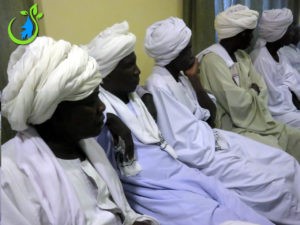
The Higher Committee for Peace
Because of that historic achievement of the Women Peace Ambassadors in Al-Malam, the US-based National Endowment for Democracy (NED) funded the Higher Peace Committee project for the three northern localities of South Darfur: Al-Malam, East Jebel Marra and Mershing. In October 2015, four Women Peace Ambassadors were selected as members of the Higher Committee for Peace.
At first, the Committee selected 20 members of the aforementioned three localities. However, due to the growing desire to participate, the number grow to be 45 members, including some influential figures from Nyala, capital of South Darfur state.
The Committee considered two mechanisms to achieve stability and prosperity: engaging with the grassroots and emphasizing the necessity to combine peace and development. The Committee sough to achieve the following tasks:
Diagnosing the crisis and identifying the causes of social disruption;
Addressing the problems at different levels by holding a series of large and closed meetings, holding town hall meetings to include the larger community. Also, preparing the community for the stage of recovery and reconciliation, and the community’s readiness to return to the villages abandoned by the war.
Holding various meetings with government officials and joint members as well as with the local leadership to ensure public security and securing villages of those who choose to return voluntarily. It also emphasized government’s key role and responsibilities in maintaining security and peace.
Identifying the needs societies in the areas of water, education, health, agriculture and herding, and what these sectors need to recover and be sustainable.
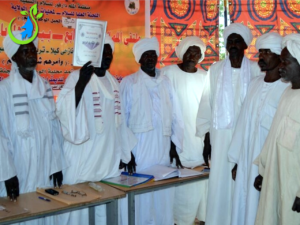
Voluntary Return Phase
Throughout 2016 and 2017, the Higher Peace Committee considered voluntary return of the IDPs to their original villages as one of its major goals. To that end, the members of the Committee took several trips between IDP camps in Nyala, Mershing, Shanagal Tobaiah, and El Fasher, the capital city of North Darfur state.
During this period, the Committee held more than 100 meetings including town hall meetings that addressed IDPs from Al-Malam locality (Kaila, Turba, Magbolah, and Shawayah). Some of these meetings included all the IDPs and other were more specific in its scope and geography. These meetings led to Social Peace Conference that aimed at coordinating efforts to receive the IDPs voluntarily returning to their hometowns.
As a result of these efforts, IDPs from Kaila finally returned to their hometown in February 2017. This was the first village to receive the returnees after 14 years of forced displacement. Their return encouraged IDPs from other villages to follow suit.
In December 2017, the Committee oversaw the return of the IDPs from Turbah. The number of returnees was approximately 5 thousand family, which was one of the largest waves of returnees since the ware.
In April 2018, the committee led the efforts to receive the IDPs from Magbolah and Shawayah. As a result, deserted villages in Al-Malam locality became populated. The next step will be returning the remaining IDPs once the development and reconstruction efforts are finalized in these villages.
Peaceful Coexistence Conference, September 2018
The High Committee for Peace After the Voluntary Return Phase
The High Committee realizes the return of IDPs to their villages in Al-Malam locality brings with it larger responsibilities than what they had done in the earlier phase. Therefore, the High Committee arranged for an inclusive conference to address the challenges that were reported upon the return of the IDPs to their villages, and to ensure social coherence and peace sustainability. To that end, the Committee called for the Peaceful Coexistence Conference on September 8-9, 2018 in Al-Malam. The conference, funded by National Endowment for Democracy (NED), allowed residents of Darfur to learn more about voluntary return program in Al-Malam locality (Kaila, Turba, Maghbolah, Sahwayah, and Um Dasho). Throughout the 2-day conference, the conference went beyond the post-return challenges in the small locality by including 6 other localities in Darfur, including localities in northern South Darfur state (Malam, Eastren Jabal Merra, Mershing, and Nitigah), as well as neighboring localities in North Darfur state (Dar Alsalam and Tawilah).
Peaceful Coexistence Conference, September 2018
The conference gathered all the stakeholders: returnees, civil societies, local leadership and chiefdom, farmers, herders, youth, women, artisans, and small business owners in both states; South Darfur and North Darfur. Central Darfur state also participated with the representation of the head of the National Administration, “Dumungai” (local leader) Sisi Fadul Sisi, who is the leader of 12 local chiefdoms in Dar Dima. The local and traditional leadership’s wisdom and experience helped formulating inclusive recommendations for peace, sustainability and expanding the voluntarily return to include more villages in Darfur.
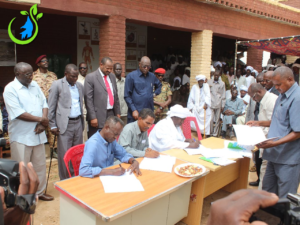
Peaceful Coexistence Conference, September 2018 – Signing ceremony
The conference set an excellent example of how local efforts could make peace that is inspired and supported by the grassroots voices. These efforts were solidified by the government’s commitment to implementing the recommendations where 6 locality mayors along with local chiefdoms signed the conference declaration. The signed declaration was also endorsed by the governors of South Darfur and North Darfur states as well as the President of MDPD.
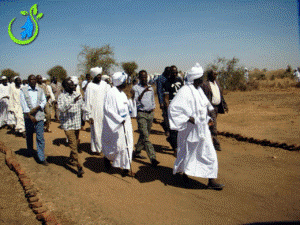
Dokari villlage
Al-Malam Example Inspires Other Localities
Due to the effective role and the positive impact of the Peace Commission in reconciliation and peacemaking, and the completion of the return of displaced persons in the localities of Al-Malam, other areas outside the locality expressed a strong desire to implement the same model to help more IDPs return to their villages. Residents of Dokari in Mershing locality contacted the Committee seeking help to apply similar programs. The impact also reached beyond South Darfur to include North Darfur State as Umda Ishaq Mastor facilitated the return of the IDPs of his villagers to Dobo village. This wide impact is one of the founding goals for MDPD that aimed to presenting a solid and program that can be applied in any war-ridden parts of Darfur.
